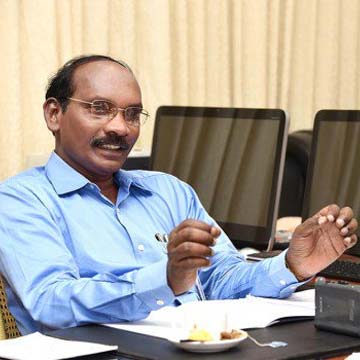 New Delhi:
New Delhi: Indian Space Research Organisation (ISRO) chairman K Sivan has been attracting flak for the controversial removal of a senior colleague and director of ISRO's, Space Application Centre, Tapan Misra, in Ahmedabad and attempts to privatise the space research agency.
In an interview to Hindustan Times, the ISRO chairman takes on the controversies head on and talks about the ongoing research and mission to moon, Chandrayaan-2, which he says is no less than the Apollo mission. He also talks about the space agency's efforts to send a man to the moon but says the immediate requirement of the country is more satellites. Edited excerpts:
In an unprecedented move, you recently removed the director Space Application Centre (SAC) Tapan Misra in Ahmedabad and he hit back saying he was sacked because he opposes privatisation of ISRO. How do you respond to these allegations?Firstly, the allegations against me attempting to privatise ISRO are baseless and without substance. People need to understand what is meant by privatisation. Does it mean handing over the agency to some private player? The answer is a big no. At ISRO we seek cooperation from industry in manufacturing parts of satellites and this is not something new. Even today, hardware or the physical work is done partially by the industry. Even at SAC Ahmedabad, some components and parts were manufactured by the industry. We have been doing this for years. In this sense of the term, we want privatisation to happen and industry should play a role in helping ISRO. Let me give an example. Two of our navigation satellites have been developed with he help of private parties. We have signed contracts to make 20 satellites with 3 agencies. Its been the mission of ISRO’s founding fathers that there should be an interplay of industry, academia and ISRO.
We have seen that in the past there has been a sudden dip in activity by ISRO, considering that for almost a year ISRO was sending out satellites almost every month.Yes, what you say is partially correct. There has been a dip in ISRO activity in the last 60-70 days. We have satellites which are ready to be launched. But in the backdrop of the recent failure of the GSAT- 6A we do not want to take chances. We are in the process of checking and re-checking the satellites ready to be launched. Recently, we called back our satellite GSAT -11 from its Guyana launch port in late April because we had doubts that the problem that plagued GSAT-6A could be there on GSAT-11 also. GSAT-6A was lost because of anomalies on board. We are again checking the launch ready satellites for discrepancies. Hence the delay.
India’s second mission to the Moon, Chandrayaan2, is one of the more talked about projects of ISRO. There are reports that the mission has missed its earlier deadline of April 2018 and is likely to be delayed further?I am optimistic that the Chandrayaan-2 mission will be launched successfully by the year-end. For the first time, ISRO is undertaking landing on another celestial body. Yes, we have faced some difficulties, because Chandrayaan-2 mission is the most complex mission attempted by ISRO so far. The mission has three components -orbiter, lander and rover. Orbiter goes around the moon and one part from the orbiter will land on the moon - the lander. From the lander another part will detach, the rover, which will study the moon. And these three components are the most complex tasks. So, if you see in the past, 47 lunar landings have happened, of which 27 have failed, pegging the success rate at less than 50%. So we set up a committee of eminent scientists from across the country who studied the project and suggested changes. It is nothing less than the Apollo mission .
While we are on the subject of Moon mission, how soon we will be able to send some one to the moon?At the moment we have no concrete plan to send a human to the moon. But we are working on the project. We are all eager to do it. The nation too is looking at ISRO to accomplish this feat. But we are waiting for the right time to do it.
Our focus right now is to serve the country and see how space programs will serve common people. At the moment we have 45 satellites in space, but the national demand today is another 45.
Can you tell us about ISRO’s forthcoming missions?At the moment our focus is on satellite missions. The thing immediately engaging us is the launch of GSAT 29. Then we are also planning the immediate launch of GSAT 11. By the middle of next year, 2019 we want to launch GSAT 20 communication satellite. These 3 satellites, along with GSAT 19, which is already in orbit, will provide the country with 100 gbps capacity which is crucial for rural connectivity. This will give a boost to prime minister’s Digital India project. Besides this we are also working on a small launcher -- a small innovative launch vehicle which could be put in service by the middle of next year. This will exclusively cater to launching of small satellites as primary payload. #Source: The HT, By Ashok Bagriya
 New Delhi: Indian Space Research Organisation (ISRO) chairman K Sivan has been attracting flak for the controversial removal of a senior colleague and director of ISRO's, Space Application Centre, Tapan Misra, in Ahmedabad and attempts to privatise the space research agency.
New Delhi: Indian Space Research Organisation (ISRO) chairman K Sivan has been attracting flak for the controversial removal of a senior colleague and director of ISRO's, Space Application Centre, Tapan Misra, in Ahmedabad and attempts to privatise the space research agency.